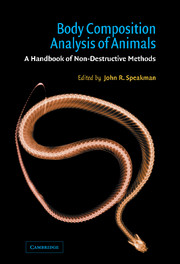Book contents
- Frontmatter
- Contents
- List of contributors
- Preface
- Acknowledgements
- Introduction
- 1 Morphological indicators of body condition: useful or wishful thinking?
- 2 Standard methods for destructive body composition analysis
- 3 The isotope dilution method for the evaluation of body composition
- 4 Gas dilution methods: elimination and absorption of lipid-soluble gases
- 5 The use of total body electrical conductivity (TOBEC) to determine body composition in vertebrates
- 6 The use of bioelectrical impedance analysis (BIA) for estimation of body composition
- 7 The assessment of body composition and other parameters by ultrasound scanning
- 8 The use of dual-energy X-ray absorptiometry for the measurement of body composition
- Index
4 - Gas dilution methods: elimination and absorption of lipid-soluble gases
Published online by Cambridge University Press: 19 January 2010
- Frontmatter
- Contents
- List of contributors
- Preface
- Acknowledgements
- Introduction
- 1 Morphological indicators of body condition: useful or wishful thinking?
- 2 Standard methods for destructive body composition analysis
- 3 The isotope dilution method for the evaluation of body composition
- 4 Gas dilution methods: elimination and absorption of lipid-soluble gases
- 5 The use of total body electrical conductivity (TOBEC) to determine body composition in vertebrates
- 6 The use of bioelectrical impedance analysis (BIA) for estimation of body composition
- 7 The assessment of body composition and other parameters by ultrasound scanning
- 8 The use of dual-energy X-ray absorptiometry for the measurement of body composition
- Index
Summary
Introduction
Technological advances have greatly enhanced the accuracy, speed, and portability of non-destructive body composition methods (Chapters 3–8), enabling insights into the physiology, ecology, evolution and reproductive biology of animals. Most non-destructive methods use a two-compartment model of body composition, providing direct estimates of non-lipid (or ‘lipid-free’) mass and estimating lipid mass indirectly, i.e. by difference: lipid mass = body mass–non-lipid mass. Since non-lipid mass frequently comprises most of the body, small errors in estimating non-lipid mass, i.e. errors as a percentage of non-lipid mass, will result in larger percent errors in lipid masses estimated by difference (Garn, 1963; Henen, 1991). Depending upon the needs of the study, non-destructive methods may provide sufficient accuracy in non-lipid and lipid mass estimates. However, some non-destructive methods may not be accurate enough for detailed analyses of energy (or other nutrient) budgets, especially for animals with small or slowly changing lipid reserves, e.g. many poikilothermic vertebrates; Henen, 1991, 1997.
Gas dilution methods may provide the requisite sensitivity and accuracy for detailed nutrient budget analyses (Lesser et al., 1952, 1960; Hytten et al., 1966; Henen, 1991, 1997; Gessaman et al., 1998). Gas dilution methods rely primarily upon the physical properties of lipids to determine body lipid content, reducing the error introduced by first estimating non-lipid mass and then calculating lipid mass by difference. When lipid mass (Ml) is smaller than non-lipid mass (Mnl; Ml<Mnl), the accurate Ml estimates from gas dilution methods allow accurate calculations of Mnl by difference.
- Type
- Chapter
- Information
- Body Composition Analysis of AnimalsA Handbook of Non-Destructive Methods, pp. 99 - 126Publisher: Cambridge University PressPrint publication year: 2001
- 1
- Cited by

